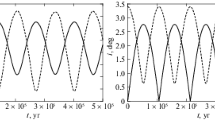Abstract
LAPLACE and Lagrange made an essential contribution to the study of the stability of the Solar System by proving analytically that, to first order in the masses, inclinations and eccentricities of their orbits, the planets move quasiperiodically. Since then, many analytic quasiperiodic solutions have been sought to higher order1–10.1 have recently constructed an extensive analytic system of averaged differential equations containing the secular evolution of the orbits of the eight main planets, accurate to second order in the planetary masses and to fifth order in eccentricity and inclination, and including corrections from general relativity and the Moon8–10. Here I describe the results of a numerical integration of this system, extending backwards over 200 million years. The solution is chaotic, with a maximum Lyapunov exponent that reaches the surprisingly large value of ∼ 1/5 Myr–1. The motion of the Solar System is thus shown to be chaotic, not quasiperiodic. In particular, predictability of the orbits of the inner planets, including the Earth, is lost within a few tens of millions of years. This does not mean that after such a short timespan we will see catastrophic events such as a crossing of the orbits of Venus and Earth; but the traditional tools of quantitative celestial mechanics (numerical integrations or analytical theories), which aim at unique solutions from given initial conditions, will fail to predict such events. The problem of the stability of the Solar System will have to be set up again, and the qualitative methods initiated by Poincare definitely need to replace quantitative methods in this analysis.
Similar content being viewed by others
References
Hill, G. W. Astr. J. 17(11), 81–87 (1897).
Brouwer, D. & Van Woerkom, A. J. J. Astr. Pap. Am. Ephem. 13(2), 81–107 (1950).
Brumberg, V. A. Analytical Algorithms of Celestial Mechanics (Nauka, Moscow; in Russian) (1980).
Bretagnon, P. Astr. Astrophys. 30, 141–154 (1974).
Duriez, L. Astr. Astrophys. 54, 93–112 (1977).
Duriez, L. thesis, Lille (1979).
Message, P. J. Celes. Mech. 26, 25–39 (1982).
Laskar, J. thesis, Observatoire de Paris (1984).
Laskar, J. Astr. Astrophys. 144, 133–146 (1985).
Laskar, J. Astr. Astrophys. 157, 59–70 (1986).
Poincaré, H. Méthodes Nouvelles de la Mécanique Celeste Vol. 1 (Gauthier-Villars, Paris, 1892).
Poincaré, H. Méthodes Nouvelles de la Mécanique Celeste Vol. 2 (Gauthier-Villare, Paris 1893).
Arnold, V. Méthodes Mathématiques de la Mécanique Classique (MIR, Moscow, 1976).
Cohen, C. J., Hubbard, E. C. & Oesterwinter, C. Astr. Pap. Am. Ephem. 22(1), 1–42 (1973).
Kinoshita, H. & Nakai, H. Celes. Mech. 34, 203–217 (1984).
Milani, A., Nobili, A. M., Fox, K. & Carpino, M. Nature 319, 386–388 (1986).
Applegate, J. H., Douglas, M. R., Gursel, Y., Sussman, G. J. & Wisdom, J. Astr. J. 92, 176–194 (1986).
Carpino, M., Milani, A. & Nobili, A. M. Astr. Astrophys. 181, 182–194 (1987).
Sussman, G. J. & Wisdom, J. Science 241, 433–437 (1988).
Newhall, X. X., Standish, E. M. & Willians, J. G. Astr. Astrophys. 125, 150–167 (1983).
Laskar, J. Astr. Astrophys. 198, 341–362 (1988).
Laskar, J. in Proc. 10th ERAM of the IAU Vol. 3 (ed. Sidlichovsky, M.) 95–98 (1987).
Nobili, A. M., Carpino, M. & Milani, A., Astr. Astrophys. (in the press).
Bennettin, G., Galgani, L., Giorgilli, A. & Strelcyn, J. M. Meccanica March 1980, 9–30.
Froeschle, Cl. in Stability of the Solar Systems and its Minor Natural and Artificial Bodies (ed. Szebehely, V. G.) 265–282 (Reidel, Dordrecht, 1985).
Berger, A., Imbrie, J., Hays, J., Kukla, G. & Saltzman, B. (eds) Milankovitch and Climate (Reidel, Dordrecht, 1984).
Author information
Authors and Affiliations
Rights and permissions
About this article
Cite this article
Laskar, J. A numerical experiment on the chaotic behaviour of the Solar System. Nature 338, 237–238 (1989). https://doi.org/10.1038/338237a0
Received:
Accepted:
Issue Date:
DOI: https://doi.org/10.1038/338237a0
- Springer Nature Limited
This article is cited by
-
Orbital Dynamics, Chaotic Orbits and Jacobi Elliptic Functions
The Journal of the Astronautical Sciences (2023)
-
Enhancing human-machine teaming for medical prognosis through neural ordinary differential equations (NODEs)
Human-Intelligent Systems Integration (2021)





